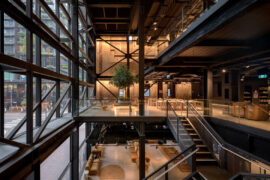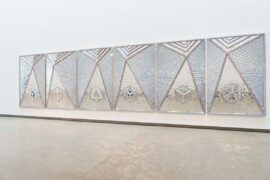We asked prominent designers travelling to Singapore a simple question: what does Australian design bring to WAF? Here are the five main topics that came up.

Allianz Stadium by Cox Architecture, photograph by Christopher Frederick Jones.
December 5th, 2023
Australian projects and designers once again performed disproportionately well on the world stage. In fact, Sydney has now posted two global winners in successive years – SJB’s 19 Waterloo Street has just won the 2023 World Interior of the Year, while Quay Quarter Tower by 3XN with BVN was recognised as World Building of the Year in 2022. Read about this year’s winners here.
Are we living through a golden era of Australian design? What makes Australian contributions to a global gathering such as WAF distinctive? From the conference floor in Singapore, we bring you insights directly from the leading practitioners who travelled to this year’s festival.


If there was one noticeable common feature of almost all the Australian project presentations, it was the acknowledgement of Indigenous life, culture and history. While it ranged from direct design engagement to a basic acknowledgement of Traditional Owners, some level of Indigenous acknowledgement was nonetheless ever-present. This is of course a welcome and commendable trend, and it invites a simple but perhaps often missing question – does the rest of the world know what we’re talking about when it comes to designing with, healing and connecting to Country? That is, Country with a decidedly upper case ‘C’?
Alex Kibble, managing director at TKD Architects, presented Alexandria Park Community School, a project in which the use of Indigenous names formed a key part of the design. “I had no idea how something like that would be perceived [at WAF],” he says. “We can only talk from our heart on this and it’s important to us. I’m not sure that the international audience fully understands what we’re talking about or why we’re talking about it, but the reason is that in the last few years we’ve got to know a whole lot more about our culture.”

The consensus on the ground seemed to be that, while recognising, honouring and learning from Indigenous connections to land and place are universal values, their particular manifestations in Australia need to be shared with the world. That is not to say, of course, that Australia has decolonised and found all the answers – quite the opposite – but that the unique features of the discourse in this part of the world can provide a beneficial model to learn from. The threading in of Indigenous ideas certainly makes Australian design richer and distinctive when compared with those presented in other postcolonial contexts without any acknowledgement of comparable histories.
Ingrid Bakker, principal at Hassell, is keen, however, to point out that “we’re not the only country doing it [connecting with First Nations people]. Canada and New Zealand have been doing it for a long time, for example – so I think it is a global concept. It’s important to talk about it in any context.”
“I do hope that we see real impact and credibility with those applications of Indigeneity in design,” adds AIA Gold Medallist Kerstin Thompson.

Designers are acutely aware that the centres of power and opinion-making in the industry are in Europe or North America. Far from automatically being a disadvantage, however, Australian architects noted that it allows for some criticism, or at least clearer appraisals, of the centre by the periphery.
Alastair Richardson, director at Cox Architecture, notes that because Australia is “at the end of the line, we have a sensibility that allows us a perspective that is very different to being at the heart of Europe, the USA or Asia – so we tend to have a better sense of oversight in terms of design. There’s a little bit of sensitivity about being at the end of the line and we seem to do things with purpose.”
Kerstin Thompson adds: “I do get frustrated by the slightly Eurocentric appreciation for architecture when it’s in Europe – there can be an exoticisation of work that comes from elsewhere. The reason I return [to WAF] is that it can take you out of your local bubble and remind you of the many parts of the world working under different conditions and offering new insights into architecture.”
Ingrid Bakker comments: “When you see Australian projects on the world stage like this, it shows the world – and ourselves, hopefully! – that we don’t need to have that cultural cringe any more. We’re actually pretty good at what we’re doing, and doing some of the best design work globally – I think we can be proud.”

Perhaps no other practice brought as many attendees or presented as many projects as Woods Bagot. Reflecting on their successes at WAF 2023, Domenic Alvaro and Tracey Wiles – global design director and principal/regional interior design leader at Woods Bagot, respectively – pointed to the strength of narrative in their projects as a key feature.
A design is nothing without a story to tell and, given the WAF format of strictly time-limited crit presentations, it’s essential that presenters get to the key points while threading a coherent and persuasive narrative. Quite why the Australians might be better at this than others is an open question…
Related: The global winners at WAF 2023

We’re not naming names here, but there is perhaps a feeling that some projects seek to muscle in on to the global stage by way of ‘shocking’ form alone – think Instagrammable funny and dramatic shapes without much in the way of connection to place or history.
“We’re not whimsical and we’re not into ‘statement’ architecture – I think we’re far more about trying to understand context, community and social life,” says Richardson.
Alex Kibble adds a similar thought: “I think what we bring to WAF is an appreciation of place – an appreciation of meaningful connection to place.”
Connection to Country, as noted above, is surely the primary way in which Australian projects are differentiating themselves. If we have only begun to scratch the surface in terms of genuinely listening to Indigenous voices in design, it gives promise for the future. The strength of the Australian projects at WAF 2023 seemed to stem primarily from connections to and narratives of place, leaving little room for spectacular formal gestures for their own sake.

While some designers were proud of an Australian emphasis on sustainability, others drew attention to the way in which WAF highlighted some of the shortcomings of the domestic design industry. “It’s interesting to see how we talk about sustainability in the Australian context – but we are so behind in sustainability,” says Richardson. “We haven’t quite grasped where Europe is on the issue, for example.”
Alex Kibble, however, adds a thought on how “our approach to sustainability is maybe a little more subtle than others.”
Kerstin Thompson concludes: “I do think that we are forced to reckon with some of the lag in our industry – that frankly we’re just not doing enough for us to deal with climate catastrophe, and it’s good to be reminded of that.”
World Architecture Festival
worldarchitecturefestival.com
Photography
Various

We think you might also like this report on the category winners from the first two days at WAF 2023.
INDESIGN is on instagram
Follow @indesignlive
A searchable and comprehensive guide for specifying leading products and their suppliers
Keep up to date with the latest and greatest from our industry BFF's!

A longstanding partnership turns a historic city into a hub for emerging talent

London-based design duo Raw Edges have joined forces with Established & Sons and Tongue & Groove to introduce Wall to Wall – a hand-stained, “living collection” that transforms parquet flooring into a canvas of colour, pattern, and possibility.

On 6th September, Saturday Indesign lit up Melbourne with a day of immersive installations, design talks and showroom activations across three thrilling precincts.

Tzannes has completed work at The Brewery in Sydney’s Central Park, marking the culmination of an internationally significant adaptive reuse project.
The internet never sleeps! Here's the stuff you might have missed

Wonderstruck is currently on view at the Queensland Art Gallery | Gallery of Modern Art (QAGOMA), an exuberant statement of flamboyant possibilities.

The undeniable thread connecting Herman Miller and Knoll’s design legacies across the decades now finds its profound physical embodiment at MillerKnoll’s new Design Yard Archives.